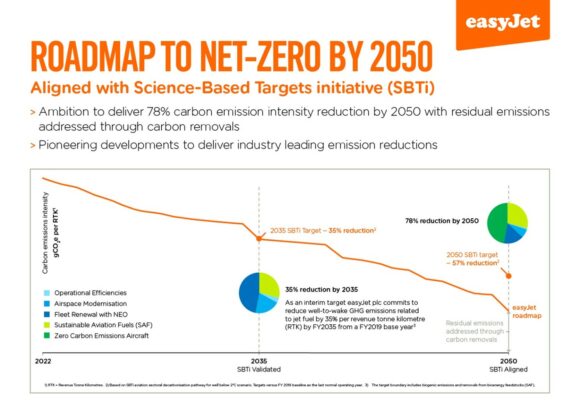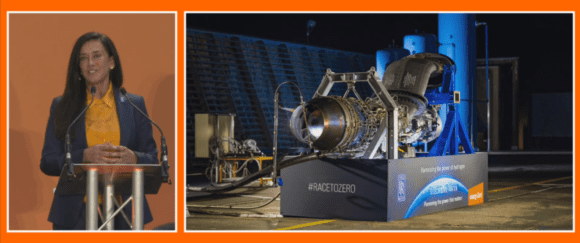
IMG 9248 scaled
easyJet says it will be able to fully reduce carbon emissions per passenger by 2050 thanks to a range of technical and operational measures. Initiatives will get emissions down by 78 percent per passenger per kilometer compared to 2019 levels, with the remaining 22 percent to be reduced by using disruptive carbon removal technology. easyJet thinks it is on-track towards net zero in 2050.
The UK-based airline announced an updated net-zero roadmap on September 26. It’s probably no coincidence that this was done on the eve of the ICAO Assembly in Montreal, which is to discuss a long-term aspirational goal on net zero emissions from September 27 to October 7. easyJet is committed to the UN’s Race to Zero on carbon emissions.
easyJet has had its roadmap validated by the Science-Based Targets initiative (SBTi). This confirmed that the previous target of a 35 percent reduction in 2035 is feasible if a set of initiatives is being applied. CEO Johan Lundgren and interim COO David Morgan detailed those initiatives today, which Morgan already highlighted to AirInsight when we spoke to him in May. “Today, we go beyond this 35 percent and go for a 78 percent reduction in 2050. We believe this is the most ambitious plan that is out there because it is very detailed”, said Lundgren in a hangar presentation.
Fleet renewal accounts for almost half of reductions until 2035
The largest chunk or almost half of carbon reduction until 2035 will come from fleet renewal. easyJet has a $21 million investment program for 168 Airbus A320neo family aircraft on order, which comes on top of the 59 neo’s that are already in the fleet. The airline confirmed an order for 56 aircraft at the Farnborough Airshow in July. “This is the single most effective way of achieving decarbonization in the near term”, said Morgan. Each neo comes with a fifteen to seventeen percent lower fuel consumption and hence lower emissions. The fleet currently totals 325 aircraft, including 171 A320ceo and A319ceo aircraft. While the A320s will continue to fly on a bit longer, the A319s will be phased out.
Over a quarter of emission reductions will come from using sustainable aviation fuels (SAF). easyJet said today that it has contracted all SAF volumes required by the roadmap for the next five years from Q8Aviation. Lundgren added that this covers the requirements from mandates, as outlined in the European Union’s Fit for 55 program: two percent in 2025 and five percent SAF in 2030. He said that easyJet is still waiting for the UK mandates from the new government, to which it has written to plead for more support and more investments that will help the aviation industry to reduce emissions. The airline is already using SAF on a limited scale in the UK and in France.
Software update will reduce fuel burn and emissions
Almost another quarter of emission reductions must come from operational efficiencies and airspace modernization. Once more, Lundgren called on Europe to finally implement the Single European Sky project, which could reduce fuel burn by ten percent. But discussion on SES has been dragging on for some twenty years and progression is slow as individual states try to maintain their own position in the air traffic management system. Lundgren and Morgan called on the UK government to modernize its airspace system, which dates back to the 1950s.
easyJet expects a one percent improvement in fuel burn across the fleet by introducing a software update to the fleet management system on all its compatible Airbus aircraft until the end of 2023. It has signed a multi-million dollar contract with the OEM to have the Descent Profile Optimization (DCO) and Continues Descent Approach (CDA) software included in the FMS.
Airbus Executive Vice President for Region and Sales Europe, Wouter van Wersch, explained that by using DPO/CDA, an aircraft will be able to continue its flight at optimal cruise altitudes longer before it starts a continuous descent. There is a potential to reduce fuel burn by up to 140.000 kilograms per aircraft per year, said Van Wersch, but in easyJet’s case, the software update will generate a 98.000-kilogram reduction in fuel burn and a 311-kilogram reduction in CO2 emissions per aircraft per year. For the entire easyJet fleet, the software update should save 88.600 tons in CO2 per year.
Morgan admitted that the benefits might not be exploited to the full, given the restrictions in airspace management that might apply: “We need to have a modernized airspace system to fully exploit the potential of DPO, but even with the existing airspace system, DPO/CDA will make a significant impact on our carbon reduction.”
Zero-emission aircraft
As David Morgan explained in May, easyJet’s long-term strategy to get to net zero will be based on the introduction of new-technology aircraft that fly on hydrogen. Since 2019, the airline has been closely involved in Airbus’ initiatives for hydrogen-based airliners and the ZEROe program. Morgan said earlier that easyJet will very likely be among the launch customers of a hydrogen airliner when it is expected to be launched around 2027-2028.
Rolls-Royce Chief Technical Officer, Grazia Vittadini, said during the presentation that the first ground test of an AE-2100 engine running on hydrogen is getting close. The first demonstration engine has been prepared and sitting on a test bed and the first batch of hydrogen has been delivered. Rolls-Royce and easyJet announced a partnership on hydrogen in Farnborough. “We recognize that hydrogen is not the only solution when it comes to decarbonizing the skies, we need to investigate more solutions, but among all of these, hydrogen is certainly the one that holds great potential. easyJet and Rolls-Royce are absolutely on the same page on this,” Vittadini said.
Rolls-Royce CTO Grazia Vittadini said a demonstrator engine of the AE-2100 that will run on hydrogen is almost ready for ground tests. (easyJet)
Zero-emission aircraft account for almost half of easyJet’s reduction target between 2035 and 2050, taking over almost the entire share from current generation aircraft that will continue to be used with SAF well until mid-century. Morgan said that the introduction of hydrogen airliners will not happen one day from the other: “This isn’t a roadmap where we use SAF until one day and the following day we flick over the hydrogen. We use SAF today and will continue to use it in 2050 and beyond because we will still have our neo aircraft in the fleet that we will still fly beyond 2050. The point at which hydrogen will be introduced and scaled up will depend on how we progress over the next few years.”
Hydrogen, SAF, plus operational and airspace improvements should get emissions per passenger per kilometer down by 78 percent in 2050, says easyJet. That leaves 22 percent to do, which counts on carbon capture technology in which carbon dioxide is extracted from the air and stored underground. In Farnborough, easyJet together with other airlines signed up for an initiative led by Airbus for large-scale deployment of this technology. Although it is new, it is already working right now but needs to be scaled up, said Morgan. That makes easyJet confident that carbon capture will be a realistic option for the final 22 percent to reduce emissions. Again, government support to develop the hydrogen infrastructure is required as will be the recognition that credits from carbon capture count under the EU’s Emission Trading Scheme (ETS).
No more carbon offsetting for easyJet
Speaking of ETS and carbon offsetting, Lundgren announced that this will no longer be a part of easyJet’s toolbox to reduce emissions. The program, in which passengers could participate by paying an additional fee on the ticket price, was launched in November 2019. Lundgren said it will end on December 31, but that flights with a departure until September 30, 2023, will still count. Only a voluntary offsetting option will be retained from January. Since the launch of the program and until June 30 this year, easyJet has offset 8.7 million tonnes of CO2 emissions.
CEO Johan Lundgren (left) and COO David Morgan during today’s presentation. (easyJet)
“The Science-Based Targets initiative doesn’t recognize out-of-the-sector carbon offsetting. So we will transition the investments that we have been doing in offsetting into the direct initiatives that we are presenting today here and reduce direct emissions from our operations”, said Johan Lundgren. He added that carbon offsetting has always been an interim measure and that his airline continues to support ICAO’s CORSIA offsetting scheme for international flights.
Lundgren is aware that terminating the program could be interpreted by the public as easyJet reducing its climate efforts, but Lundgren and Morgan stressed that the opposite is true. He isn’t concerned either that customers might be worried that a large chunk of what they pay will be invested in these net-zero technologies: “From studies is clear that customers expect from a company to actually do a transition (to clean technology).”
Lundgren said that easyJet has a backup plan, in case its 2050 targets might not look achievable: “If we are seeing that with the best of our knowledge today that one of two initiatives don’t develop as quickly as one could have expected, we can dial up activities in other parts of the plan and still reach the same result.”
Views: 13







